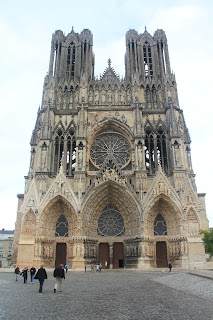Next, we were off to one of the highlights of the day. You can't go to the Champagne region without touring a champagne cave! We chose the Taittenger company tour, and we were both impressed. We began with a short video that shared the history of the company and champagne in general. We learned that we were in an abbey that was originally built during the 400's. The monks began carving out caves beneath the abbey during this time. The ground is made of chalk which naturally creates the perfect environment for storing and aging wine and champagne. Initially, the monks made delicious wine, but around the 1200's, they began experimenting and eventually created the champagne that we know (and love) today. When the video was complete, we toured the caves beneath the abbey.
In just the caves owned by Taittenger, there were 19 million bottles of champagne and each company throughout the Champagne region has similar caves with a similar number of bottles. Now, that's a lot of champagne!! Each batch of champagne must ferment twice in order to give it the bubbly finish. First, it must ferment in either an oak barrel or a steel drum. Then, it is bottled with more yeast and sugar. It is corked and left to age for anywhere from 3-10 years. At the end of this time, it has built up pressure, accumulated carbon dioxide bubbles, and formed a sediment from the dead yeast. The final step is to remove the sediment. The bottles are placed horizontal and turned 1/8 to a 1/4 cm every few days for two months. The turning of the bottles is still done by hand by workers who can turn up to 8,000 bottles in an hour! With every turn, the bottles are placed more and more vertical until they are standing on their cork. At this point, the sediment is in the neck of the bottle, so the two centimeters of champagne closest to the cork is frozen. The cork is removed along with the frozen champagne and sediment! A tiny bit of champagne and pressure is lost, but it is replaced with cane sugar and wine depending on how sweet or dry the final product is intended to be. It was fascinating and cold in the chalk caves, so we were all eager to head upstairs for a taste!
After the champagne caves, we headed to the Notre Dame cathedral of Reims. The church is one of the oldest and most impressive gothic cathedrals in Europe. Much of the church was destroyed during WWI and then rebuilt just in time for WWII; however, some of the stained glass was removed during the war and dates back to the 1200's. It wasn't the most lavish church that we've seen, but the stain glass was truly incredible!
We left the church, and found the statue of Joan of Arc. She was from the Champagne region and led the troops who defeated the English ending the 100 Year War. She led the Coronation of Charles VII in Reims after several victories.
We were unable to see the small WWII museum, but Reims was significant because the official Nazi surrender took place there!
By this point in the day, we were both quite tired, so we had some espresso and relaxed in a park that had old Roman arches dating back to the 400's. It's impossible to comprehend how far back European history goes when we come from a country that was born less than 250 years ago.
We took advantage of the small microbrewery that the town had to offer knowing that good beer in France was hard to come by. We each tried a sampler and decided that even the darkest of the beers was bland in comparison to what we were used to.
We picked up a couple of macaroons, strawberry and pistachio, and we decided that this would be our supper. The two cookies were crunchy on the outside, soft and moist on the inside, and filled with a smooth pastry cream. It was a perfectly sweet end to such a wonderful day.
We picked up a couple of macaroons, strawberry and pistachio, and we decided that this would be our supper. The two cookies were crunchy on the outside, soft and moist on the inside, and filled with a smooth pastry cream. It was a perfectly sweet end to such a wonderful day.
















No comments:
Post a Comment